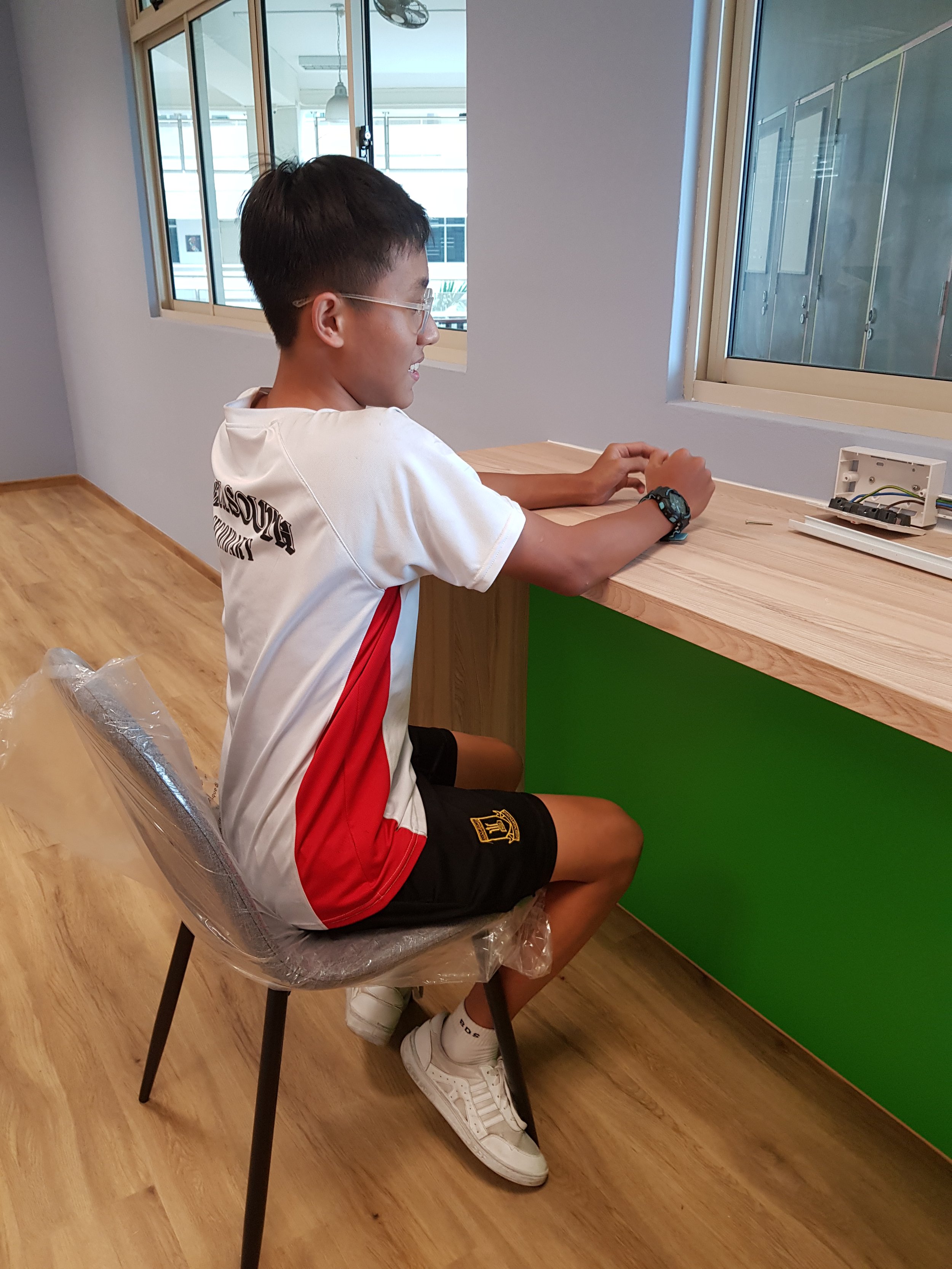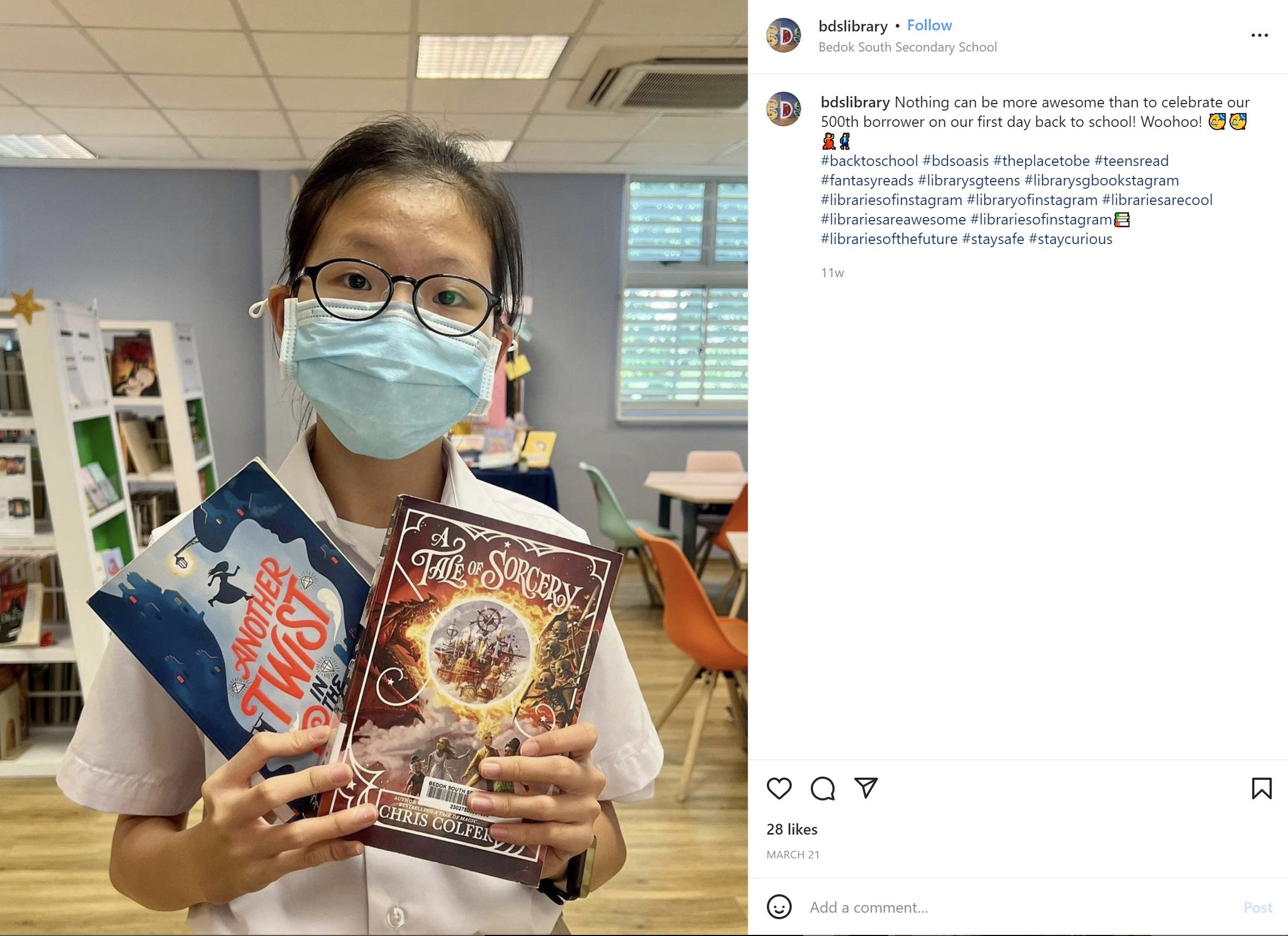Redesigning for small spaces
Oasis at Bedok
South Secondary
The revamped Oasis@BDS is borne out of a concerted effort to operationalize the 21st Century School Libraries Framework by a dedicated team of staff members.
Officially opened in 2019, the library serves Secondary 1 - Secondary 5 students with varying levels of reading competencies.
A Tripartite, Two-Phased Approach
Pre-renovation Bedok South Library
Revamped Oasis@BDS
Work on the new library began in two phases. The first phase started in 2018, with a tripartite effort between consultants from the National Library Board, National Institute of Education and Bedok South Secondary School. The team tapped on the expertise provided by the National Library Board (NLB) to best optimise the limited space they were working with to operationalise the 21st Century School Library Framework.
To maximise the limited space the school was working with, NLB consultants made several recommendations.
Shelves were shifted away from the windows to maximise the amount of natural light coming into the library and to give the perception was open and airy. The NLB consultants also recommended a minimum distance of 1.1 metres between shelves to allow easy access for users browsing for materials.
The library layout and furniture were planned in a way where the noisy zones were clustered closer to the entrance of the library, leading to quiet zones further inside the library.
Using design thinking principles, the National Library Board (NLB) held focus group discussions with various stakeholders to identify the different user types as well as better understand their pain points. These were then taken into consideration by Joanne and the BDS team.
The school made use of the 21st Century School Library Framework to make the library more relevant to the students’ lives.
Ms Joanne Lee, Library Co-ordinator
(Bedok South Secondary School)
The team decided to focus on improving reading habits, enhancing library programmes and increasing library usage amongst the school diverse student population. Phase 1 works completed in early 2019 and the library was put into use then.
Work on the makerspace within the library only started in 2019, after the launch of the main library. Launched in 2020, a consistent application and implementation of the design allowed the two spaces to remain visually coherent. In keeping with the library’s aesthetic of having long sightlines to create a sense of space, glass partitions separate the makerspace from the main library space.
Prototyping and charting their own path
The team wanted to incorporate high chair sitting areas - but had no reference point as to how high the high chairs had to be for these areas for users aged between 12 to 17 years old.
Having fully committed to the design thinking process, the team began to prototype and test, getting students from the different age groups to trial and sit on chairs of varying heights at the high chair sitting area. (see above)
We invited several Secondary 1 and 4 students to test the heights of different chairs to best determine which would work for the different age groups.
Ms Joanne Lee
The end result of this process (see below) is two slightly different high-sitting areas that can cater to all students between 12 - 17 years old. This approach and attention to detail is important as it more accurately addresses the pain points unique to different user groups within the library.
Zoning Spaces for Specific Uses
The new library is clearly split into different zones, each with a unique name and attends to one or more aspects in the 21st Century School Library Framework.
The new school library with its curated book collection is less intimidating than the public libraries. It’s easier for me to pick out a book to read.
Jenny, Secondary 2 (Class of 2021)
“The Haven” is a space designed to allow students a comfortable sitting area for users to read independently or in social groups. Magazines and newspapers are also placed in close proximity for browsing. The weeded and revamped book collection also support the library’s mission to support reading.
Spaces like “The Connexion” is structured to facilitate collaborative working behaviours. It features group sitting areas and a whiteboard for students to use during brainstorming sessions.
The library has also catered space for students who wish to study/research independently at “The Virtual Sphere” and “The Study Sanctuary”. Seats at the latter come with power plugs to allow students to recharge their electronic devices.
I like the book collection because there’s many different genres and they are placed in like (a) nice, organized space.
Aliyah, Secondary 3 (Class of 2021)
The school also managed to put in a multi-purpose space during the revamp. Named “The Eclectic Space”, it is a place that serves as an activity (Doing) space for readers’ theatre, small workshops and talks. The space also becomes an informal sitting area for students to engage in studying or research for their assignments.
Forward-looking Programming
The school also adopted a holistic “heartware” approach where it came to the library’s programming. Teachers, CCA groups and even the parent support group (PSG) came together to run programmes that broadened the scope of learning and expanded the library’s position in the consciousness of students.
These monthly library activities are largely focused on activities beyond the curriculum, which is in-line with shaping the library as a holistic learning hub.
Ms Joanne Lee
The library committee does this by forecasting the library event calendar a year early. By planning ahead and seeking help from teachers/CCA groups early, events like Mothers’ Day see the Arts Department coming to the library to run Mothers’ Day card-making workshops for students. In the same vein, parents and CCA groups can also see where they fit in the calendar and plan ahead to execute programs that broaden the horizons of the students. So far, the PSG has organised an nagomi art session while the Girl Guides in Bedok South have also stepped in to teach their peers how to make shrink art keychains as a de-stress activity.
I’m with the Girl Guides. We have an annual collaboration with the school library to run programs. This year (2021), we ran a crafts workshop two weeks before the term exams to help our schoolmates de-stress.
Aliyah, Secondary 3 (Class of 2021)
The library has also embraced social media in its bid to connect with students. Their handle @bdslibrary, serves as a portal to update students about upcoming workshops and is the platform where they regularly feature their hundredth borrower and the books they are reading.
During the pandemic, this online presence has kept the library prescient in the minds of the students. The VP and teachers took to the platform then to share about their favorite books.
Digital Screens and NLB Integration
In collaboration with NLB, the new library space also features a digital screen which directly taps into the National Library Board’s extensive digital repository.
Each month, NLB and the school library committee work together to curate the digital book display to reflect the monthly themes/focus.
To use these screens, students can click on the book covers to bring up the titles that interest them. This brings up a QR code, which allows them to scan with their mobile device and borrow using a mobile application should they wish to.
The integration with the National Library Board digital repository has increased the school’s ability to provide relevant reading materials for our higher competency readers who demand more challenging texts. The NLB digital repository also allows us to tap on e-Resources that are not in our physical collection, complementing and expanding our readers’ horizon.
Ms Joanne Lee
Future-ready Libraries
Libraries in the 21st century need to embrace the multi-faceted roles they play to develop the skills and dispositions towards reading, research, collaboration, study and doing. The team at Oasis@Bedok South have definitely demonstrated that with a lot of grit and heart, even smaller libraries are able to evolve effectively and serve student needs.
“We’re happy to find the library is now a space that is being used and is relevant to the students’ lives at Bedok South.” said Ms Joanne Lee.
Editor's note - The names of the students appearing in this article have been replaced with pseudonyms.


















